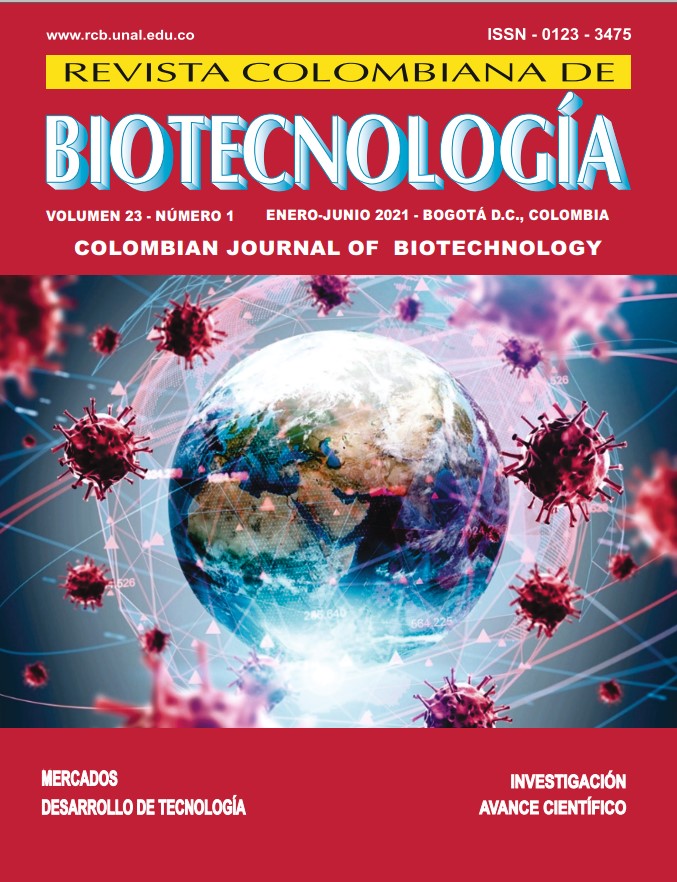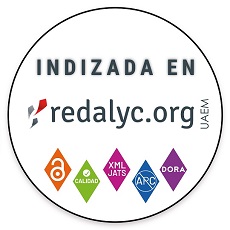Bacterias aisladas de biosólidos de la PTAR San Fernando en Medellín-Colombia con capacidad para reducir cromo hexavalente
Hexavalent chromium-reducing bacteria on biosolids from the San Fernando Wastewater Treatment Plant in Medellín (Colombia)
DOI:
https://doi.org/10.15446/rev.colomb.biote.v23n1.94005Palabras clave:
bacteria, bioremediation, biosolids, chromium, heavy metals, hexavalent, reduction. (es)bacteria, bioremediation, biosolids, chromium, heavy metals, hexavalent, reduction. (en)
Descargas
En las últimas décadas se ha trabajado activamente para reducir el impacto ambiental generado por las actividades antrópicas que constantemente liberan componentes tóxicos al ambiente generando inestabilidad y daños en la salud de las comunidades biológicas. Entre los diferentes contaminantes, los metales pesados revisten importancia en virtud de sus propiedades, que dificultan su degradación o transformación en otros compuestos menos tóxicos. El cromo es uno de los metales de mayor interés a nivel global por su uso en múltiples industrias. Los métodos convencionales que utilizan materiales cromados en sus procesos, no sólo arrojan cantidades considerables de residuos al ambiente, sino que dan poca cuenta de la fracción de Cr6+ presente en determinados ecosistemas. La biorremediación se ha propuesto como una alternativa económicamente viable y ambientalmente sostenible. El propósito del presente trabajo fue evaluar la capacidad de reducción de cromo por bacterias, aisladas de una matriz de biosólidos de la Planta de tratamiento de aguas residuales (PTAR) San Fernando en la ciudad de Medellín-Colombia. Muestras de biosólidos se cultivaron en Agar Nutritivo enriquecido con diferentes concentraciones de Cr6+. Las cepas que presentaron mayor tolerancia al cromo fueron aisladas para realizar ensayos de reducción por triplicado, monitoreando la concentración del metal en el tiempo. Se obtuvieron siete especies bacterianas diferentes dentro de las cuales se destacaron Staphylococcus saprophyticus, Ochrobactrum anthropi y Bacillus cereus por la capacidad de reducir Cr6+ a 96 h con eficiencias de 29.0%, 61.1% y 100%, respectivamente.
During the most recent decades, advances have been made to reduce the environmental impact by anthropogenic activities that constantly release toxic components into the environment, generating instability and damage to the health of biological communities. Among the different pollutants, heavy metals are important by virtue of their properties, which hinder their degradation or transformation into other less toxic compounds. Chromium is one of the metals of greatest global interest due to its use in multiple industries. Conventional methods using chromed materials in their processes, not only throw considerable amounts of waste into the environment, but also give little account of the fraction of hexavalent chromium (Cr6+) present in certain ecosystems. Bioremediation has been proposed as an economically viable and environmentally sustainable alternative. This work aimed to evaluate the chromium reduction capacity by bacteria isolated from a biosolids matrix obtained at the San Fernando Wastewater Treatment Plant (WWTP), located in Medellín (Colombia). Biosolids samples were grown in a nutrient agar enriched with different concentrations of Cr6+. The strains presenting the greater tolerance to chromium were isolated to perform reduction tests by triplicate, monitoring the concentration of the metal over time. Seven different bacterial species were obtained, among which Staphylococcus saprophyticus, Ochrobactrum anthropic, and Bacillus cereus showed the greatest ability to reduce Cr6+ (29.0%, 61.1 and 100%, at 96 h) respectively.
Referencias
Banerjee A, Ghoshal A., 2016, Biodegradation of phenol by calcium-alginate immobilized Bacillus cereus in a packed bed reactor and determination of the mass transfer correlation. Journal of Environmental Chemical Engineering 4(2):1523–1529. DOI: https://doi.org/10.1016/j.jece.2016.02.012
Benila J, Sumithra P., 2017, Optimization of chromium biosorption by fungal adsorbent, Trichoderma sp. BSCR02 and its desorption studies. HAYATI Journal of Biosciences 24(2):65–71 DOI: https://doi.org/10.1016/j.hjb.2017.08.005
Chacon L., 2014, Prueba de shapiro-wilk para probar normalidad de Luis Chacon Montalvan en Prezi. [Online]. Available: https://prezi.com/vnmuq6wdkl49/prueba-de-shapiro-wilk-para-probar-normalidad/. [Accessed: 12-Mar-2018].
Cheng Y, Yan F, Huang F, Chu W, Pan D, Chen Z, Zheng J, Yu M, Lin Z, Wu Z., 2010, Bioremediation of Cr ( VI ) and Immobilization as Cr ( III ) by Ochrobactrum anthropic. Environmental Science & Technology. 44(16):6357–6363 DOI: https://doi.org/10.1021/es100198v
Chudasama K, Thaker V. S., 2017, Genome sequence of Ochrobactrum anthropi strain SUBG007, a plant pathogen and potential xenobiotic compounds degradation bacterium. Genomics Data 11: 116–117 DOI: https://doi.org/10.1016/j.gdata.2017.01.001
Eastmond D, MacGregor J, and Slesinski R., 2008, Trivalent chromium: Assessing the genotoxic risk of an essential trace element and widely used human and animal nutritional supplement. Critical Reviews in Toxicology 38(3):173–190 DOI: https://doi.org/10.1080/10408440701845401
Elabbas S, Mandi L, Berrekhis F, Noelle M, Pierre J, Ouazzani N., 2016, Removal of Cr (III) from chrome tanning wastewater by adsorption using two natural carbonaceous materials: Eggshell and powdered marble. Journal of Environmental Management 166:589–595 DOI: https://doi.org/10.1016/j.jenvman.2015.11.012
Fernández P, Viñarta S, Bernal A, Cruz E, Figueroa L., 2018, Bioremediation strategies for chromium removal: Current research, scale-up approach and future perspectives. Chemosphere 208:139-148. DOI: https://doi.org/10.1016/j.chemosphere.2018.05.166
Francisco R, Alpoim M. C, V Morais P V., 2002, Diversity of chromium-resistant and -reducing bacteria in a chromium- contaminated activated sludge. Journal of applied Microbiology. 92(Vi) 837–843. DOI: https://doi.org/10.1046/j.1365-2672.2002.01591.x
Glick B, Pastemak J., 1985, Chapter 14 Bioremediation and Biomass Utilization. Molecular Biotechnology 3a–4a ed. ASM press 1:551–598
Gutiérrez J, Espino Á, Coreño A, Acevedo F, Reyna G, Fernández F, Tomasini A, Wrobel K, Wrobel K., 2010, Mecanismos de interacción con cromo y aplicaciones biotecnológicas en hongos. Revista Latinoamericana de Biotecnología Amb Algal 1(1):47–63
Haviari S, Cassier P, Dananché C, Hulin M, Dauwalder O, Rouvière O, Bertrand X, Perraud M, Bénet T, Vanhems P., 2016, Outbreak of Achromobacter xylosoxidans and Ochrobactrum anthropi infections after prostate biopsies, France, 2014. Emerging Infectious Diseases. 22(8):1412–1419 DOI: https://doi.org/10.3201/eid2208.151423
Henderson A, See G, O’Donohoe T, Aye C, Parsonson F, Engler C, Norton R., 2016, Misidentification of Brucella suis as Ochrobactrum anthropi in a Patient with Septic Arthritis. Clinical Microbiology Newsletter. 38(8):66–68 DOI: https://doi.org/10.1016/j.clinmicnews.2016.04.002
Higdon J, Drake V, Delage B., 2003, Centro de Información de Micronutrientes: Cromo. Linus Pauling Institute Oregon State University. http://lpi.oregonstate.edu/es/mic/minerales/cromo. [Accessed: 16-Nov-2019].
Horel S., 2017, Cáncer profesional: sólo 18 sustancias reguladas. Portal Libertario OACA. Available: https://www.portaloaca.com/articulos/mundo-natural/12905-cancer-profesional-solo-18-sustancias-reguladas.html. [Accessed: 28-May-2018]
Ibrahim H., 2011, Characterization of biosurfactants produced by novel strains of Ochrobactrum anthropi HM-1 and Citrobacter freundii HM-2 from used engine oil-contaminated soil. Egyptia Journal of Petroleum. 6(2):1–9 DOI: https://doi.org/10.1007/s13205-016-0540-5
Ilhan S, Nourbakhsh M, Kiliçarslan S, Ozdag H., 2004, Removal of chromium, lead and copper ions from industrial waste waters by Staphylococcus saprophyticus. Turkish Electronic journal Biotechnol. 2:50–57
Iranzo M, Gamón M, Boluda R, Mormeneo S., 2018, Analysis of pharmaceutical biodegradation of WWTP sludge using composting and identification of certain microorganisms involved in the process. Science of the Total Environment 640–641: 840–848. DOI: https://doi.org/10.1016/j.scitotenv.2018.05.366
Jobby R, Jha P, Yadav A, Desai N., 2018, Biosorption and biotransformation of hexavalent chromium [Cr(VI)]: A comprehensive review. Chemosphere 207:255–266. DOI: https://doi.org/10.1016/j.chemosphere.2018.05.050
Martínez M., 2009, Aislamiento de cepas nativas bacterianas a partir de biopelícula obtenida de un sitio de vertimiento de aguas residuales con alto contenido de cromo, Tesis de Maestría. Universidad Nacional de Colombia, Medellín, 79p.
Mellado J., 2013, Homogeneidad de Varianzas Prueba de Bartlett [Online]. Available: http://www.uaaan.mx/~jmelbos/cursos/bart.pdf. [Accessed: 12-Mar-2018].
Ministerio de Vivienda Ciudad y Territorio, 2014, Decreto 1287 de julio 10 de 2014. [Online]. Available: http://legal.legis.com.co.ezproxy.unal.edu.co/document/legcol/legcol_fe34d0ded1e6033ce0430a010151033c/decreto-1287-de-julio-10-de-2014?text=biosolidos&type=q&hit=1. [Accessed: 06-Sep-2015].
Mora A., 2016, Bacillus sp. G3 un microorganismo promisorio en la biorremediación de aguas industriales contaminadas con cromo hexavalente. Nova Scientia. 8(17):361. DOI: https://doi.org/10.21640/ns.v8i17.655
Nayak P., 2017, Containing contamination: Trees, fungi and bacteria to the rescue. Current Science. 112(3):447–448
Pacific Northwest National Laboratory, 2012, In Situ Bioremediation [Online]. Available: http://bioprocess.pnnl.gov/resour/rt3d.in.situ.bioremediation.htm. [Accessed: 12-Jun-2016].
Pan X, Liu Z, Chen Z, Cheng Y, Pan D, Shao J, Lin Z, Guan X., 2014, Investigation of Cr(VI) reduction and Cr(III) immobilization mechanism by planktonic cells and biofilms of Bacillus subtilis ATCC-6633. Water Research. 55(Vi): 21–29 DOI: https://doi.org/10.1016/j.watres.2014.01.066
Qian J, Zhou J, Wang L, Wei L, Li Q, Wang D, Wang Q., 2017, Direct Cr (VI) bio-reduction with organics as electron donor by anaerobic sludge. Chemical Engineering Journal. 309(127):330–338 DOI: https://doi.org/10.1016/j.cej.2016.10.077
R-core team, 2017 “R-student.” softward
Removal of chromium by Staphylococcus saprophyticus subsp. bovis strain 1. Alekhya C, Subbaiah M (2016). Biologija 62(1):1-8 DOI: https://doi.org/10.6001/biologija.v62i1.3285
Rivera E, Cárdenas J, Martínez V, Acosta I., 2015 Remoción de cromo (VI) por una cepa de Aspergillus niger resistente a cromato. Información Tecnológica 26(4):13–20 DOI: https://doi.org/10.4067/S0718-07642015000400003
Sánchez J, Correa M, Castañeda L, 2016, Bacillus cereus un patógeno importante en el control microbiológico de los alimentos. Revista Facultad Nacional de Salud Pública 34(2):230–242. DOI: https://doi.org/10.17533/udea.rfnsp.v34n2a12
Singh N, Gaur R., 2013, Detoxification of hexavalent chromium by an indigenous facultative anaerobic Bacillus cereus strain isolated from tannery effluent. African Journal of Biotechnology. 12(10): 1091–1103
Sokal R, Rohlf F., 1995, Biometry: the principles and practice of statistics in biological sciences. New Yorkk: WH Free Company.
Tahri N, Sayel H, Bahafid W, El Ghachtouli N., 2011, Mechanisms of hexavalent chromium resistance and removal by microorganisms. Reviews of Environmental Contamination and Toxicology 211: 25–61
Trois C, Coulon F, de Combret C, Martins J, Oxarango L., 2010, Effect of pine bark and compost on the biological denitrification process of non-hazardous landfill leachate: Focus on the microbiology. Journal of Hazardous Materials, 181(1–3):1163–1169 DOI: https://doi.org/10.1016/j.jhazmat.2010.05.077
Tunjuelo. Soto C, Gutiérrez S, Rey A, González E., 2010, Biotransformación de metales pesados presentes en lodos ribereños de los ríos Bogotá y Tunjuelo, Nova 1:195–205 DOI: https://doi.org/10.22490/24629448.450
US EPA, 1992, Test
US-EPA, 1992, Methods for the Detection of Microorganisms in the Environment NEPIS. p. 128.
Vargas M, López M, Suárez F, Moreno J., 2012, Compost as a source of microbial isolates for the bioremediation of heavy metals: In vitro selection. Science of the Total Environment 431:62–67 DOI: https://doi.org/10.1016/j.scitotenv.2012.05.026
Wang Y, Peng B, Yang Z, Chai L, Liao Q, Zhang Z, Li C., 2014, Bacterial community dynamics during bioremediation of Cr(VI)-contaminated soil. Applied Soil Ecology 85:50–55. DOI: https://doi.org/10.1016/j.apsoil.2014.09.002
Wise S, Wise J., 2012, Chromium and genomic stability. Mutation Research - Fundamental and Molecular Mechanisms o f Mutagenesis Mutagen 733(1–2):78–82 DOI: https://doi.org/10.1016/j.mrfmmm.2011.12.002
Cómo citar
APA
ACM
ACS
ABNT
Chicago
Harvard
IEEE
MLA
Turabian
Vancouver
Descargar cita
CrossRef Cited-by
1. Ajit Pratap Singh Yadav, Vinay Dwivedi, Satyendra Kumar, Anil Kumar. (2023). ChrR Gene Variability in Cr-stressed Leptolyngbya boryana for the Biotransformation of Cr (VI) to Cr (III). Journal of Pure and Applied Microbiology, 17(1), p.439. https://doi.org/10.22207/JPAM.17.1.36.
Dimensions
PlumX
Visitas a la página del resumen del artículo
Descargas
Licencia

Esta obra está bajo una licencia internacional Creative Commons Atribución 4.0.
Esta es una revista de acceso abierto distribuida bajo los términos de la Licencia Creative Commons Atribución 4.0 Internacional (CC BY). Se permite el uso, distribución o reproducción en otros medios, siempre que se citen el autor(es) original y la revista, de conformidad con la práctica académica aceptada. El uso, distribución o reproducción está permitido desde que cumpla con estos términos.
Todo artículo sometido a la Revista debe estar acompañado de la carta de originalidad. DESCARGAR AQUI (español) (inglés).


















